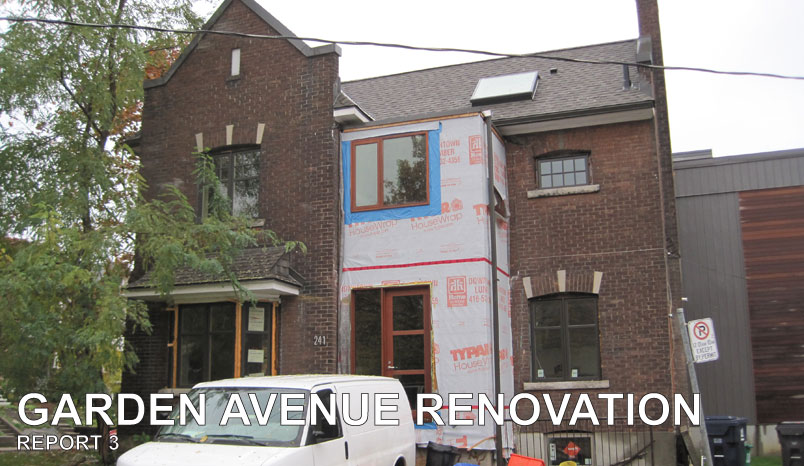
DOWNLOAD PRINTABLE PDF
January 2013
Work on Nick and Julia's Garden Avenue house has been progressing well since our last report. Over the summer and autumn, the building envelope and systems have been installed in preparation for the interior finish work. The Garden Avenue home incorporates up-to-date sustainable house design elements, especially when it comes to the heating, cooling and ventilation systems. In this house we are heating with small radiators that maximize the amount of usable space in each room. The radiators are fueled by a super high-efficiency boiler, roughly the size of a small backpack, which functions for both hot water and space heating. Cooling for the house is performed using an energy efficient air-to-air ductless heat pump, which uses one main exterior condenser unit with three interior heads: one in the living room, one in the kitchen and one at the top of stair case on the second floor. Avoiding the need for large, extensive ductwork reduces the overall project cost, and ensures more open interior spaces. Ventilation is provided by a high-efficiency Heat Recovery Ventilator (HRV). HRVs capture the warmth of outgoing air, which has already circulated through the space, and uses that heat - or recycled energy - to warm the incoming outside air. Ductwork for an HRV system is small and can easily fit through interior partition walls and floors, making it easy to introduce in a retrofit application. Although the system can run throughout the year, it is mostly used when the windows are closed and alternative ventilation is required. This century Toronto home has solid-brick walls that sit directly on the stone foundation walls. To insulate this type of wall, we installed 4" of water-based spray-in-place polyurethane foam directly onto the inside face of the brick, and have carried it all the way down to the basement footings with minimal breaks. Spray-foam uniquely adheres to masonry surfaces - common to most older Toronto-area homes - and provides a high level of insulation and a total air seal. The product we used, by Icynene, installs with a water-based blowing agent that greatly reduces unhealthy off-gassing into the interior spaces and doesn't cause the wider environmental emissions associated with other spraying agents such as aerosol. Another element of this green home building envelope is the windows, which have now all been installed! All are double-glazed, and those on the west side of the house contain a reflective coating to reduce summer heat-gain while still creating a bright interior. The windows in the addition spaces are Bauhaus solid wood units, while the original walls are installed with Marvin wood-clad aluminum windows. The Marvin units are made with extruded aluminum that typically includes 30-35 percent post-consumer recycled content and 40 percent post-industrial scrap material. The plumbing system uses an efficient PEX tubing system, made of extruded high-density polyethylene (HDPE). We like to use PEX over more traditional metal piping materials for a number of practical and environmental reasons. The key difference with PEX tubing is its flexibility. This means it can be shipped in more efficient, longer lengths than rigid piping; it is easier to install in complex spaces; and it requires far fewer connector fittings since it can easily take a 90-degree turn without breaking. The HDPE material doesn't suffer from corrosion or scale build-up like with copper, and unlike copper and rigid plastics, PEX is far less likely to break in freezing temperatures. Lastly, PEX is less of a heat conductor than metal alternatives, creating a much more energy efficient plumbing distribution system overall. We are very excited to see this project moving along so smoothly, and will be ready to announce completion early next year. The final step is interior finishes! |








|